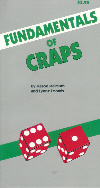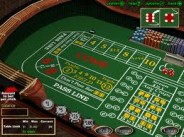
Fundamentals of Craps

The Do's and Don'ts of Craps
Many gamblers think that craps as a relatively new game popularized by casinos early in the twentieth century. But tracing its roots back through the ages reveals a surprisingly much longer history. J. Phillip Vogel is considered a leading authority in online gambling. He has written for most of the major gaming publications worldwide including Casino Player, Strictly Slots, Gambling Online, Bluff, and many more. He is also the author of a series of best-selling gambling books collectively titled The Real Deal. He is the founder of online watchdog site TheOPN.com at www.theopn.com and currently serves as the Editorial Director for Poker Life magazine. In Roman times, soldiers tossed the cubed bones of animals for sport in an effort to pass the long hours of servitude, from which sprang the phrase "roll the bones." Centuries later, Arabian gamers devised their own interpretation, called "az-zahr," which eventually spread through medieval Europe as "Hazard." Over time, the game shifted again, becoming "Crabs" (referring to the lowest possible roll, a pair of ones) when played by the English aristocracy, and "Crabes" in France, until reaching the Americas and finally settling down in early 19th century as "Craps." Editor's note: For further reading, see our Craps History article.
J. Phillip Vogel is considered a leading authority in online gambling. He has written for most of the major gaming publications worldwide including Casino Player, Strictly Slots, Gambling Online, Bluff, and many more. He is also the author of a series of best-selling gambling books collectively titled The Real Deal. He is the founder of online watchdog site TheOPN.com at www.theopn.com and currently serves as the Editorial Director for Poker Life magazine. In Roman times, soldiers tossed the cubed bones of animals for sport in an effort to pass the long hours of servitude, from which sprang the phrase "roll the bones." Centuries later, Arabian gamers devised their own interpretation, called "az-zahr," which eventually spread through medieval Europe as "Hazard." Over time, the game shifted again, becoming "Crabs" (referring to the lowest possible roll, a pair of ones) when played by the English aristocracy, and "Crabes" in France, until reaching the Americas and finally settling down in early 19th century as "Craps." Editor's note: For further reading, see our Craps History article.
Although craps is a relatively player friendly game with a low house edge, because of its chaotic appearance gamblers unfamiliar with it often shy away. But once you get past its deceptive exterior, craps is actually one of the easiest games on the casino floor. At its most basic level, craps is comprised of two stages:
Stage 1: The Come Out Roll. Craps begins with the initial roll of the dice, called the "come out" roll. With the come out, the shooter throws the dice, determining whether the game will begin or end on that roll. For example, if the shooter throws a 2, 3, 7, 11, or 12 the round ends there. If any other total is rolled-4, 5, 6, 8, 9, 10-that number becomes the "point," and the dealer places a small round "puck" on the table at that number's location, announcing to all players the point for the round.
Stage 2: After the Point. Once a point number has been established, the game continues with the same shooter throwing until a decision is reached: either the point number is re-rolled, or a seven shows. Once either of those happens, that round is over, and the game starts all over again.
Prior to the start of the Stage 1 and continuing until the game is over, players can make a variety of different wagers. Some are betting that the shooter will re-roll the point number-known as the "Do" side of the game-while others are betting that the shooter will roll a seven before the point number is rolled; such players are called "Don't" bettors. Still others are betting on rolls that are completely unrelated to the point. Let's take a look at some of the most common bets from both sides of the game.
The Do Side
Pass Line: An even money bet made by placing chips in the area marked "Pass Line." This wager wins if the first roll of the dice is a 7 or 11, and loses if a 2, 3 or 12 is rolled. If a 4, 5, 6, 8, 9 or 10 is rolled, that number becomes the "Point." Once there is a point number, to win the player must repeat that number before a 7 is rolled. If a 7 shows before the point is repeated, the pass line bet loses.
Come Bet: The come bet is a delayed pass line bet made after the point has been established on the come out roll. The rules are identical to the pass line bet: the come bet wins if a 7 or 11 is rolled and loses on a 2, 3, or 12. Any other number becomes your "come point" and must be repeated before a 7 is rolled.
Taking Odds: The odds bet is a supplemental wager made after a point has been established and is used to support the pass line bet. This bet is made in multiples (usually up to 2x) of the pass line bet. If the pass line bet wins, the original pass bet will be paid at 1 to 1, while he supplemental wager will be paid at odds of 2-1 if the point was 4 or 10, 3-2 if the point was 5 or 9, and 6-5 if the point was a 6 or 8.
The Don't Side of Craps
Don't Pass: The opposite of the pass line bet, a don't pass bet wins if the shooter rolls a 2 or 3 on the come out roll and loses if a 7 or 11 is rolled. If a 12 is rolled, it's a tie and play continues. Once the point has been established, a don't pass bet wins if the shooter rolls a 7 before repeating the point.
Don't Come Bet: The opposite of the come bet, the don't come may be wagered once the point has been established on the come out roll. An initial roll of 7 or 11 loses, 2 or 3 wins, and a 12 is a push. If a 4, 5, 6, 8, 9 or 10 is rolled after a don't come bet has been made, the dealer will move the wager from the don't come area to the corresponding number.
Laying Odds: As opposed to "taking odds," when laying odds the player is betting that the 7 will show before the point number is rolled. This bet is made in multiples of the don't pass wager and is paid off at odds of 1-2 if the point is 4 or 10, 2-3 if the point is 5 or 9, and 5-6 if the point is 6 or 8.
While craps offers many other betting options such as place bets and proposition bets, until you get an experienced hand at the game it's best to stick with the basics just described.
Quick Betting Reference
For easy reference, below is a summary of the main features for the various bets in craps, including a basic description, payout, and corresponding house edge.
|
Bet
|
Basic Description
|
Pays
|
Vigorish
|
|
Big Six
|
Six shows before seven |
1-1
|
9.09
|
|
Big Eight
|
Six shows before seven |
1-1
|
9.09%
|
|
Buy 4
|
Four shows before seven |
39-21
|
4.76%
|
|
Buy 5
|
Five shows before seven |
29-21
|
4.76%
|
|
Buy 6
|
Six shows before seven |
23-21
|
4.76%
|
|
Buy 8
|
Eight shows before seven |
23-21
|
4.76%
|
|
Buy 9
|
Nine shows before seven |
29-21
|
4.76%
|
|
Buy 10
|
Ten shows before seven |
39-21
|
4.76%
|
|
Come
|
Delayed Pass Line Bet |
1-1
|
1.41%
|
|
Don’t Come
|
Delayed Don’t Pass Bets |
1-1
|
1.37%
|
|
Don’t Pass
|
Betting against the point |
1-1
|
1.37%
|
|
Hard 4
|
Roll 2-2 before seven/easy four |
7-1
|
11.1%
|
|
Hard 6
|
Roll 3-3 before seven/easy six |
9-1
|
9.09%
|
|
Hard 8
|
Roll 4-4 before seven/easy eight |
9-1
|
9.09%
|
|
Hard 10
|
Roll 5-5 before seven/easy ten |
7-1
|
11.1%
|
|
Lay 4
|
Seven shows before four |
1-2
|
2.44%
|
|
Lay 5
|
Seven shows before five |
2-3
|
3.23%
|
|
Lay 6
|
Seven shows before six |
5-6
|
4.00%
|
|
Lay 8
|
Seven shows before eight |
5-6
|
4.00%
|
|
Lay 9
|
Seven shows before nine |
2-3
|
3.23%
|
|
Lay 10
|
Seven shows before ten |
1-2
|
2.44%
|
|
Pass Line
|
Betting on the point |
1-1
|
1.41%
|
|
Place 4
|
Four shows before seven |
9-5
|
6.67%
|
|
Place 5
|
Five shows before seven |
7-5
|
4.00%
|
|
Place 6
|
Six shows before seven |
7-6
|
1.52%
|
|
Place 8
|
Eight shows before seven |
7-6
|
1.52%
|
|
Place 9
|
Nine shows before seven |
7-5
|
4.00%
|
|
Place 10
|
Ten shows before seven |
9-5
|
6.67%
|
|
Bet
|
Brief Description
|
Pays
|
Vigorish
|
|
Any Craps
|
2, 3, or 12 on next roll |
7-1
|
11.1%
|
|
Any Seven
|
A one-roll on the seven |
4-1
|
16.2%
|
|
Field
|
2, 3, 4, 9, 10, 11 or 12 next roll |
2-1
|
5.56%
|
|
Hop (two numbers) |
Any specified two numbers |
15-1
|
11.1%
|
|
Hop (one number) |
Any pair of numbers |
30-1
|
13.9%
|
|
Horn
|
2, 3, 11, or 12 next roll |
By number |
12.5%
|
|
Horn (2 or 12 high) |
2, 3, 11, or 12, double on 2 or 12 |
By number
|
12.8%
|
|
Horn (3 or 11 high) |
2, 3, 11, or, 12; double on 3 or 11 |
By number
|
12.2%
|
|
World
|
2, 3, 7, 11, or 12 next roll |
By number
|
13.3%
|
|
2
|
Two shows on next roll |
30-1
|
13.9%
|
|
3
|
Three shows on next roll |
15-1
|
11.1%
|
|
11
|
Eleven shows on next roll |
15-1
|
11.1%
|
|
12
|
Twelve shows on next roll |
30-1
|
13.9%
|

